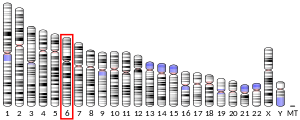Fibrocystin
Fibrocystin is a large, receptor-like protein that is thought to be involved in the tubulogenesis and/or maintenance of duct-lumen architecture of epithelium.[5] FPC associates with the primary cilia of epithelial cells and co-localizes with the Pkd2 gene product polycystin-2 (PC2), suggesting that these two proteins may function in a common molecular pathway.
| Fibrocystin | |
|---|---|
| Identifiers | |
| Symbol | Fibrocystin |
| InterPro | IPR029927 |
| Membranome | 632 |
Pathology
Mutations of its encoding gene (chromosomal locus 6p12.2) can cause autosomal recessive polycystic kidney disease.
References
- GRCh38: Ensembl release 89: ENSG00000170927 - Ensembl, May 2017
- GRCm38: Ensembl release 89: ENSMUSG00000043760 - Ensembl, May 2017
- "Human PubMed Reference:". National Center for Biotechnology Information, U.S. National Library of Medicine.
- "Mouse PubMed Reference:". National Center for Biotechnology Information, U.S. National Library of Medicine.
- Zhang M, Mai W, Li C, Cho S, Hao C, Moeckel G, Zhao R, Kim I, Wang J, Xiong H, Wang H, Sato Y, Wu Y, Nakanuma Y, Lilova M, Pei Y, Harris R, Li S, Coffey R, Sun L, Wu D, Chen X, Breyer M, Zhao Z, McKanna J, Wu G (2004). "PKHD1 protein encoded by the gene for autosomal recessive polycystic kidney disease associates with basal bodies and primary cilia in renal epithelial cells". Proc Natl Acad Sci USA. 101 (8): 2311–2316. doi:10.1073/pnas.0400073101. PMC 356947. PMID 14983006.
External links
- GeneReviews/NIH/NCBI/UW entry on Polycystic Kidney Disease, Autosomal Recessive
- fibrocystin+protein,+human at the US National Library of Medicine Medical Subject Headings (MeSH)
This article is issued from Wikipedia. The text is licensed under Creative Commons - Attribution - Sharealike. Additional terms may apply for the media files.



